The latest project management trends reveal that activity scheduling, artificial intelligence (AI), and collaboration features are popular among teams. It’s not surprising, as modern businesses focus more on adhering to timelines, automating routine processes, and communicating with colleagues remotely. With such valuable capabilities, many are compelled to adopt software solutions, driving the industry’s overall growth.
Learn about the latest project management trends to know which emerging solutions and strategies are worth adopting to cope with the challenges of handling projects, complex or otherwise.
Project Management Solutions
The project management software market is expected to increase at a compound annual growth rate (CAGR) of 15.7% from 2023 to 2030, according to Grand View Research. The growth will be supported by businesses’ need for platforms that offer real-time insights into resource performance, facilitate effective communication among geographically scattered team members, and provide excellent visibility on project updates.
In this section, we’ll discuss how businesses have been using project management technologies to help you maximize your tools.
1. The majority prefer project management software solutions over spreadsheets
Source: Capterra
Seventy percent of surveyed participants said they implement project management platforms, while 17% rely on spreadsheets. Only 8% track project activities manually. These project management industry statistics show that the majority see the benefit of adopting software solutions. Project management software has built-in activity scheduling, task tracking, and workload management features, making handling projects from start to finish easier.
2. Activity scheduling platforms are the most popular type of project management solution
Source: Grand View Research
Activity scheduling solutions represented the largest market share in 2022, accounting for 27.28% of the total. The next most popular platforms were project portfolio management, resource management, and issue tracking.
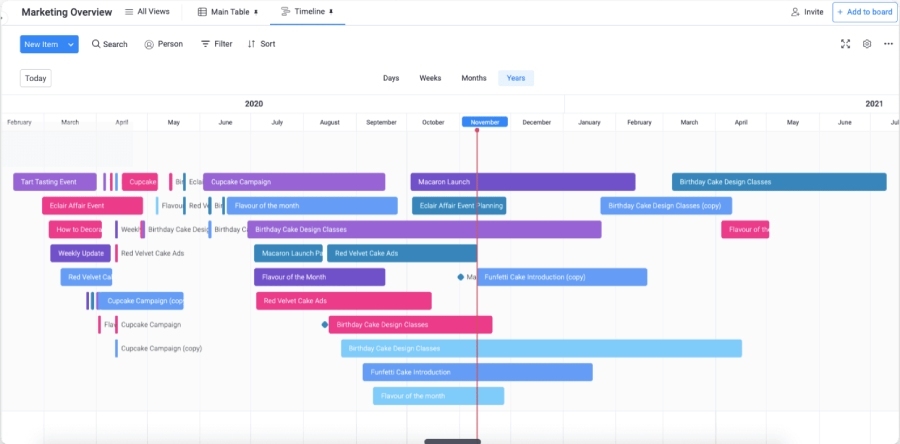
Create easy-to-understand project schedules on monday.com. (Source: monday.com)
monday.com is an excellent activity scheduling platform that allows users to plot key events and deliverables in a visually appealing timeline. Define your baseline to monitor work progress over time and ensure everything’s on track. Set milestones to immediately spot bottlenecks that derail timely project delivery.
Take advantage of monday.com’s free version and access more than 200 project templates. For more advanced activity scheduling features, subscribe to its entry-level plan priced at $12 per user, per month for a minimum of three seats.
3. 33% of project managers use artificial intelligence (AI) for automation
Source: Software Advice
Many professionals have adopted AI to make project monitoring more efficient. Some common applications include generating reports and activity updates. Aside from automation, AI is useful for determining the best way to allocate resources.
About 32% of the respondents apply AI tools to improve resource management. AI processes large volumes of data, including performance metrics, allowing the technology to provide recommendations for distributing resources strategically. Meanwhile, 27% of professionals asserted that AI improved the quality and precision of project metrics.
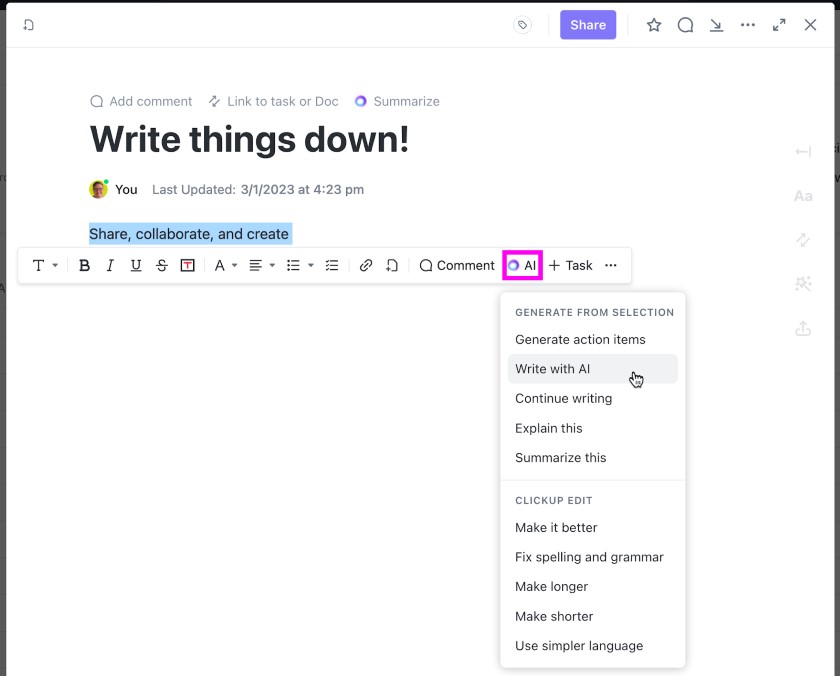
Write content faster with ClickUp AI. (Source: ClickUp)
ClickUp is one of the top project management platforms with a robust AI feature. It automates repetitive tasks, recommends actionable insights to prevent project delays, and generates content, including blogs, marketing plans, and other business documents. If you’re keen on using this platform, the entry-level subscription is priced at $10 per user, monthly. Try the free version first to see if it suits your project needs and goals.
4. Issue-tracking software accounts for the largest market share in the project management software industry
Source: Datanyze
One of the most interesting project management industry trends is the large population of niche-specific software users. As of this writing, Jira is the most popular project management tool, representing almost 25% of the market share. It’s an in-demand platform among software developers, as it offers robust tools for Agile project management, namely scrum boards, story points, version management, and backlog grooming.
Microsoft Project places second among the top project management technologies with a 14% share. Kanban, Airtable, Smartsheet, and Asana were the next most popular.
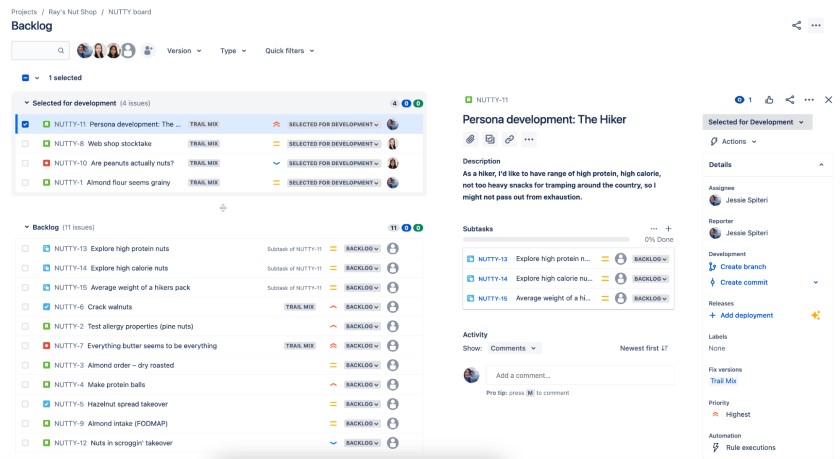
Get an overview of issues on Jira’s backlog. (Source: Jira)
Jira features a Kanban backlog, which allows you to list issues or tasks for sprint planning. It has a drag-and-drop functionality for prioritizing to-dos. To further organize task lists, you can create subtasks from the parent tasks or split an issue. Jira’s entry-level subscription plan costs $8.15 per user, monthly.
5. Trello, an easy-to-use platform, is the top-reviewed project management solution
Source: G2
Trello recorded the most reviews on the review platform G2 in 2023, earning over 13,000 user reviews. ClickUp is the next most reviewed tool, with over 8,000 reviews. Meanwhile, monday.com had the highest net promoter score among the three platforms, reaching 83, which suggests that the platform offers an outstanding solution for handling projects.
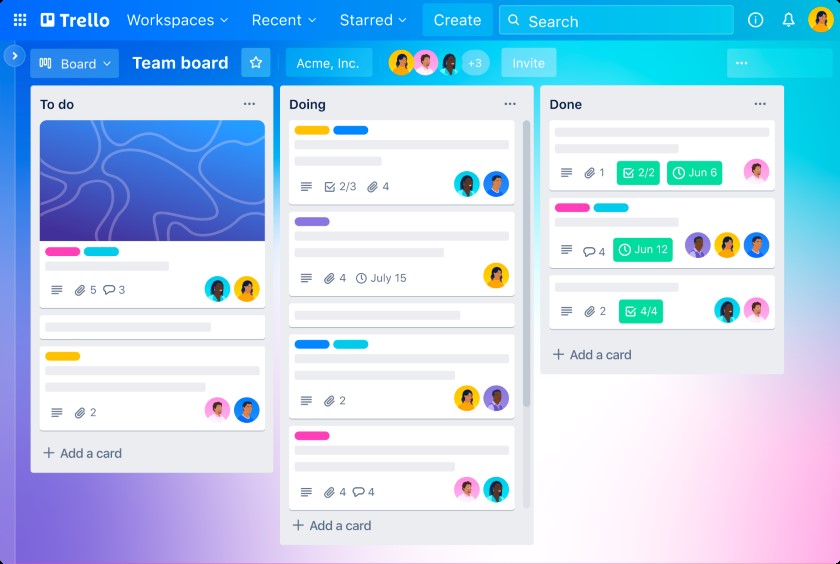
Track project status through Trello’s easy-to-use Kanban board. (Source: Trello)
Trello is a project management platform known for its intuitive, beginner-friendly interface. Its default view is a Kanban board, which has three columns: “To do,” “Doing,” and “Done.” Drag and drop task cards to appropriate columns as team members work on specific assignments. Enable automation to reduce the manual work of keeping the board up to date.
The platform’s free version features unlimited cards, activity logs, and integrations. But if you want unlimited boards and advanced project views, such as timeline and map views, upgrade to the paid plans, which start at $5 per user, per month.
Project Management Strategies
Since every project is unique, the approach to achieving objectives and working on tasks varies from one team to another. However, when you look at the trends in project management, you’ll uncover patterns that may apply to your own initiatives. In this section, we’ll tackle the prevailing strategies project teams use.
6. ‘Mature organizations’ completed over 50% of their projects on time in 2022
Source: KPMG
Sixty-seven percent of companies said they finished more than 50% of their projects within their set schedule, a 15% increase from 2021. Seventy-four percent said they completed more than half of their projects within budget. Meanwhile, 85% claimed that they delivered successful projects with stakeholder satisfaction. The success can be attributed to the maturity level of the organization. A “mature” team thoroughly defines its processes, methodologies, tools, and culture for project delivery.
7. Almost 40% of project managers use a hybrid approach combining waterfall & Agile methodologies
Source: Project Manager
Waterfall and Agile are the most popular project management methodologies among the companies surveyed, and 39% said they use a hybrid of waterfall and Agile when handling projects. Interestingly, 18% shared that they apply many styles within a single initiative.
The waterfall approach involves a sequential, linear process of tackling a project, wherein each phase is finished before moving to the next. The Agile style entails breaking down the project into smaller cycles called sprints, a predefined time period wherein the team will accomplish a set amount of work.
8. Improved work visibility is the top reason practitioners use the Kanban framework
Source: Kanban University
Close to 75% of survey respondents said they adopted a Kanban approach to projects to enhance work visibility. Fifty percent hoped that the framework would facilitate continuous improvement. Other major reasons include increasing delivery speed, improving lead time, and managing chaos. Visualize your workflows better by exploring the best Kanban software solutions.
9. Project teams lean toward Gantt charts to plan & track projects
Source: Project Manager
Over 60% of respondents said they use a Gantt chart for 50% to 100% of their projects. When compared to other formats, 36% use Gantt charts, 21% use task lists, 16% use Kanban boards, and 15% use spreadsheets.
A Gantt chart is a horizontal bar chart that shows a list of project activities laid out against dates. The length of the bar indicates the amount of time required to complete the tasks. If you’re looking for a project management solution with this visual tool, check out our buyer’s guide on the best Gantt chart software.
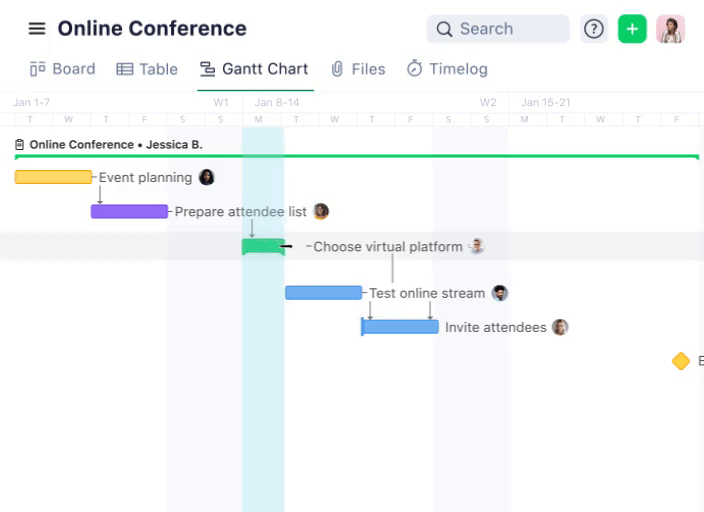
Get an overview of the entire project via Wrike’s Gantt view. (Source: Wrike)
Wrike provides a bird’s-eye view of project activities through the Gantt chart. It’s useful for keeping track of the project’s progress and gauging if the work pace will catch up to the set deadlines. Similarly, it helps see task dependencies since the activities are laid out in chronological order. Although Wrike offers a free version, its Gantt chart feature is available only on the paid plans. The monthly subscription starts at $9.80 per user.
10. 71% implement the Agile methodology in software development projects
Source: Digital.ai
The current trends in project management show that engineering and research and development project teams are the fastest-growing adopters of the Agile methodology, recording a 16% increase over 2022. Among the Agile users, 63% said they use scrum, the project management framework that emphasizes iterative and incremental processes to achieve goals.
Adopting Agile offered project teams various benefits. Almost 60% of respondents said they improved collaboration, while 57% claimed that the methodology allowed them to align work to business needs. Meanwhile, 36% said that Agile project management offered a better work environment.
11. Almost 60% of project practitioners collaborate in person or via virtual meetings
Source: Project Manager
Only 9.4% use project management software, 6.7% on task management platforms, and 2.2% on project portfolio management systems. To avoid switching between multiple apps and breaking the momentum of collaboration and productivity, teams need to find comprehensive software solutions offering not only project management capabilities but also team engagement features.
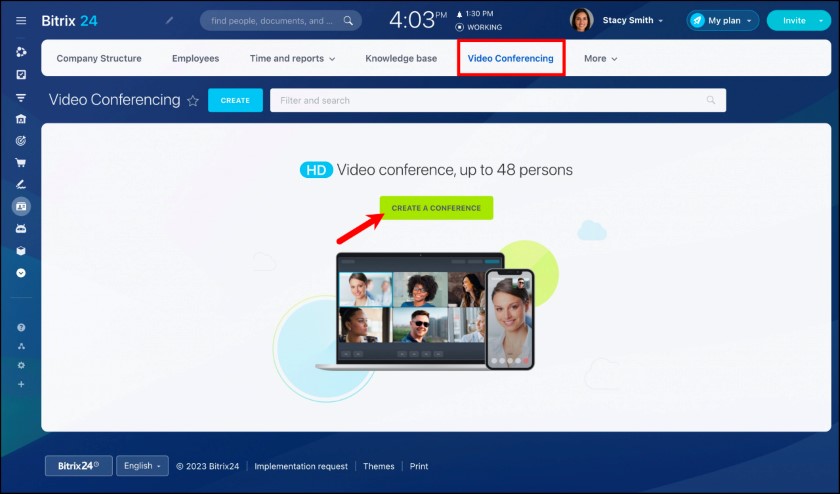
Meet colleagues virtually via Bitrix24’s built-in video conferencing tool. (Source: Bitrix24)
Bitrix24 is one of the project management platforms equipped with a video meeting feature. It offers in-meeting collaboration tools like chat and hand-raise. The free version of the platform accommodates a maximum of 12 participants, while the paid version supports up to 48 users. If you’re interested in this platform, subscribe for only $61 per month for five users.
12. Prioritizing ‘power skills’ increases the likelihood of project success
Source: Project Management Institute
Power skills include communication, problem-solving, collaborative leadership, and strategic thinking. The surveyed respondents claimed that 72% of their projects achieved business goals as they adopted power skills. Only 28% of the projects experienced scope creep or the tendency for deliverables to increase over time and the timeline to be extended. In addition, only 17% of initiatives suffered a budget loss when a project failed.
Project Management Challenges
While project management has seen various new technologies in the past decades, businesses encounter obstacles in handling different initiatives all the same. In this section, we’ll explore the top project management challenges teams encounter.
13. 45% of managers claimed that reorganization of team members makes projects challenging
Source: Smartsheet
Almost all project managers (91%) admitted that they encounter project management challenges. The top reason is team members being shuffled from project to project. Meanwhile, 40% claimed the challenge is brought about by remote work, while 34% claimed it is due to extended time leave. When projects fail, 58% of managers get frustrated, 31% experience burnout, and 27% feel embarrassed.
14. Lack of clear strategy is the top reason teams hesitate to adopt AI
Source: Capterra
About 28% of surveyed participants identified unclear strategy as the major barrier to artificial intelligence (AI) adoption. The next biggest obstacle is ethical and security concerns (26%), AI technology immaturity (25%), and inadequate IT support (25%).
The key to overcoming the lack of strategy is to be deliberate in drafting a business case for investment in AI to inspire adoption. Using peripheral AI may likewise help the organization ease into using the technology while reaping its benefits.
15. 77% don’t have enough resources to meet project demand
Source: KeyedIn
The current trends in project management show that allocating resources strategically is a tough task for project management professionals, with over 50% of the surveyed respondents admitting that resource management is a serious concern. The majority of them (42%) claimed that capacity planning is the most challenging, followed by resource allocation (37%) and resource utilization (11%).
Frequently Asked Questions (FAQs)
No. While AI will reduce manual work and improve various aspects of project management, including task automation, data processing and analysis, and risk reduction, the project manager role will not be replaced completely.
Several areas of project management require human touch, such as rapport-building with internal and external stakeholders, conflict resolution, decision-making, and adaptation to rapid changes. All of these will be hard for AI to develop and replicate.
The golden triangle in project management is a project management model that illustrates the three key variables that affect project quality: scope, cost, and time.
The project management life cycle refers to the phases you must take to successfully handle a project from start to finish. It includes initiation, planning, executing, monitoring and controlling, and closing. Learn more about it in our comprehensive guide on project management for small businesses.
Bottom Line
The latest project management trends show that project teams have been maximizing software solutions to successfully deliver projects and reach business goals. The majority rely on intuitive, easy-to-use, and niche-specific platforms, like Trello and Jira, to track activities more efficiently.
However, challenges remain, particularly in AI adoption, resource management, and overall team organization. By clearly defining the project’s objectives, scope, and team member responsibilities, these obstacles can be overcome. Explore the best project management software solutions today as you prepare for your next initiative.